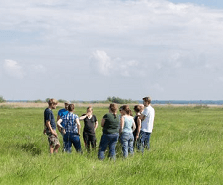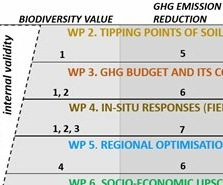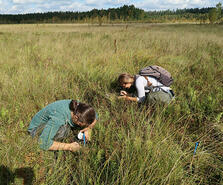Study Area
PRINCESS focuses on the most heavily degraded and nitrogen-affected peatlands in temperate Europe, in particular in the participating EU countries, which are all rich in peatlands/organic soils (Austria: 1,200 km², Belgium: 248 km², Finland: 90,000 km², Germany: 18,320 km², Norway: 44,700 km², and Poland: 14,950 km²; Tanneberger et al. 2017). In Belgium, Germany, Austria, and Poland, more than 75% of peatlands are degraded, and in particular agriculturally used peatlands are important GHG sources (e.g. in Germany contributing 37% to total agricultural emissions and in Poland 42%). In contrast, peatlands in the very peatland-rich Scandinavian countries are much less degraded (Finland 50-75% and Norway <25%, respectively).
Bringing together research partners from six countries, experimental and field research focuses on temperate fens (i.e. groundwater-fed peatlands), which cover more than one third of Europe’s peatland area. Temperate fens are largely drained and agriculturally used, emit substantial amounts of GHG as a result, and are subject to the highest nitrogen loads (cf. Tanneberger et al. 2017). The severe degradation translates into disproportionally high importance of fens with regard to the EU policy goals listed above. Still, fens are less well studied than rainwater-fed bogs (cf. BiodivERsA PEATBOG project). GHG emission characteristics and compliance with the other policy objectives of rewetted, formerly agriculturally used peatlands in interaction with nitrogen loads have not yet been studied despite being clearly interlinked. For instance, high nitrogen loads in drained peatlands cause both nitrate production and GHG emissions also in the form of the very potent N2O. Rewetting increases nutrient retention, including by denitrification, and effectively stops N2O emissions. As N2O emissions are targeted to drop by only 20% according to the Paris Agreement, rewetting can create a surplus on this target, which may compensate for the associated methane emissions and may ease the burden of reduction in other sectors.
The different levels of investigation from microcosm and mesoscosm scale via field experiments to landscape and EU scale maximizes internal and external validity of our results. GHG and socio-economic scenarios covering EU27 at a large scale and more detailed country-level analyses including national transformation pathways for some of the most peatland-rich countries in the EU will complement and upscale results gained from meta-analyses and experimental research.











